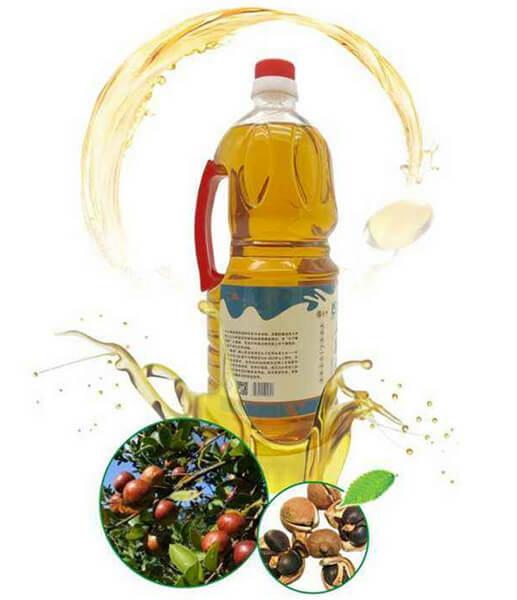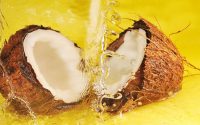Tea Seed Oil Production Line
Tea Seed Oil Production Line Introduction
Tea seed oil production line adopts low-temperature screw pressing technology to extract oil from raw tea seeds. The oil extraction production line is compact in design, has a small footprint, and it is easy to operate and easy to maintain. It is widely used in small and medium oil production plants.
Production Process of Tea Seed Oil Extraction Line
The comprehensive production process of tea seed oil is as follows:
Seed material→drying→cleaning and removing impurities→shelling→separation→seed kernel→crushing→water conditioning→pressing→crude oil (pressed cake)→fine filtration (leaching)→pure tea seed oil (oil cake).
1. Drying
If the water content of the harvested tea seed is too high, the husk is hard to be broken and the plasticity is large. The squeezing is easy to excrete. Therefore, Camellia seeds with high water content should be dried so that the moisture content does not exceed 5% in order to dehull and roll the embryos. Tea seed drying is very important in oil extraction, and the quality of tea seed drying has a direct effect on the oil yield.
1.1 Changes of heat and steam pressure in drying tea seed
The drying process of tea seeds is divided into three stages: 1. In the preheating stage, the heat supplied by hot air to camellia seed is used to increase the temperature of the camellia seed, and a small portion of the heat is used to vaporize the free water of the camellia seed. With the increase of the temperature of the camellia seed, The partial pressure of steam on the surface is also rising, and the water vaporization rate is also increasing rapidly; 2. In the constant-speed drying stage, the water vapor pressure on the surface of tea seed is in the saturation state corresponding to the temperature of the tea seed at this time. The drying speed is constant, which is equal to the diffusion rate of the moisture from the surface of the camellia seeds to the surrounding medium, and the moisture content decreases linearly; 3. In the slow-down period of drying, the moisture inside the camellia seeds is transferred to the surface and evaporated–that is, the heat and moisture transfer process, until the moisture contained in the camellia seeds is balanced with the humidity of the hot air, and the temperature of the material rises to the same temperature as the medium.
1.2 Tea seed drying method
The tea seed is generally dehydrated by low-temperature baking and drying method because the outside of the tea seed kernel is covered with a densely organized tea seed husk, which hinders the heat transfer and moisture evaporation processes of the tea seed kernels. Most of the moisture is concentrated in tea seed kernels. A plate dryer is used to control the steam pressure of the interlayer which should be heated to about 0.2MPa, and the tea seed kernel with a moisture content of about 8% is dried to a moisture content of about 4% to minimize the free moisture in the kernel and facilitate water conditioning.
2. Cleaning and Removing Impurities
The purpose of cleaning is to increase the oil production rate, to improve the quality of tea seed oil and the utilization value of oil cake, to improve the treatment ability of the machine, to reduce the wear degree of the equipment, and to increase the processing capacity of the equipment. Cleaning methods include screening, destoner machine, magnetic separation, removal of side-by-side mud, dry specific gravity sorting and other methods.
The camellia seeds after drying should be cleaned of empty shells, dirt, and other debris. And the process requirements for seed cleaning are as follows: The maximum impurity content of the clean oil tea seed is less than 0.2%; the amount of tea seed in the waste is less than 0.5%.
3. Shelling and Separation
The impact mill is used to break the seed husk, and the husk is thin, and after drying, it contains few moistures and is easily broken. The requirements of shelling and kernel shell separation are: high shell breaking rate, no seed leakage, small powder degree; and there are two main indicators for the separation of kernel shells, that is, shell percentage in kernel and kernel percentage in the shell. Obviously, the lower the kernel percentage in the shell, the better the oil output rate, which is beneficial to the full utilization of raw materials and the increase of oil yield and cake yield.
The kernel percentage in the shell can be set to 0.3%. The shell percentage in the kernel is hoped to be as low as possible, but there are two points to consider: one is that, with a low shell content, the squeezing chamber of the oil press is easily locked by the pressed material, causing slippery buckling. The squeezing is difficult to carry out. The second is to consider the solvent leaching of the cake. When the cake contains fewer shells, there is no skeleton, the material layer is easily compacted, and the solvent penetrates difficultly, resulting in high residual oil in the oil cake, affecting leaching efficiency and solvent consumption. Based on the above two points, after repeated testing, we found that the best value for shelling is to separate about 75% of the tea seed shell content.
4. Crushing
A toothed roll crusher is used to crush the kernels containing a certain amount of shells. The purpose is to granulate and homogenize the seeds of different sizes so that they have the largest surface area and are conducive to the water conditioning. However, the degree of powder cannot be too large, so the spacing between the two-toothed rollers should be strictly controlled.
5. Water Conditioning
After the addition of water, the entire structure of the tea seed kernel has changed greatly, which facilitates the extrusion of the oil. Considering the plasticity and elasticity of the squeezed material, the water content is generally controlled at about 2%.
Low-Temperature Oil Pressing Advantages

- Improve the quality of raw tea seeds and ensure the quality of raw tea seeds;
- Avoid the dark color of tea seed hulls affecting the product color;
- Avoid the poor quality of mildew tea seed materials into the production process, which ensures the crude oil quality;
- Avoids the dark color and odor of tea oil caused by high temperature;
- Compared with the traditional technology, low-temperature tea seed oil pressing technology has the advantages of simple process, good oil quality, energy saving, low investment in equipment, small area, etc. The finished tea seed oil obtained through this pressing process has light yellow, clear and transparent look, fresh fragrance. It is not only good edible oils but also has health care functions and can be used as makeup oil, thus improving the economic and social benefits of tea seed.


